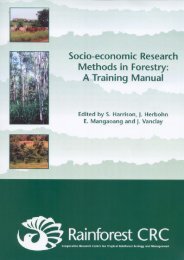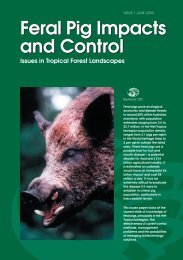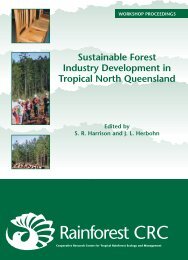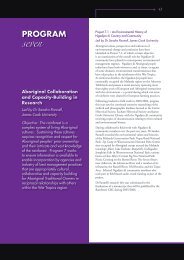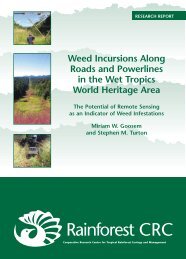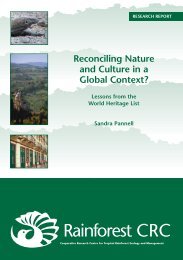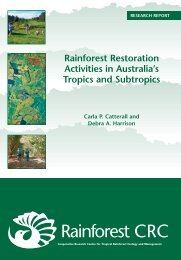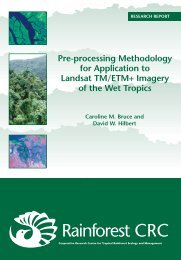Reconciling Nature and Culture in a Global Context? - Rainforest ...
Reconciling Nature and Culture in a Global Context? - Rainforest ...
Reconciling Nature and Culture in a Global Context? - Rainforest ...
You also want an ePaper? Increase the reach of your titles
YUMPU automatically turns print PDFs into web optimized ePapers that Google loves.
<strong>Reconcil<strong>in</strong>g</strong> <strong>Nature</strong> <strong>and</strong> <strong>Culture</strong> <strong>in</strong> a <strong>Global</strong> <strong>Context</strong>?Lessons from the World Heritage ListTo support this assertion, the nom<strong>in</strong>ation relies upon the 1986 report commissioned by theAustralian Heritage Commission, <strong>and</strong> two articles identified <strong>in</strong> the appended bibliography;one by the anthropologist Norman T<strong>in</strong>dale on the ‘Prehistory of the Aborig<strong>in</strong>es’, <strong>and</strong> one bythe palaeobotanist Peter Kershaw on ‘Aborig<strong>in</strong>al burn<strong>in</strong>g dur<strong>in</strong>g the last twoglacial / <strong>in</strong>terglacial cycles’. The Ra<strong>in</strong>forest Conservation Society of Queensl<strong>and</strong> (RCSQ)report itself provides three pages of <strong>in</strong>formation on the ‘history of Aborig<strong>in</strong>al occupation’ ofthe region (1986: 39-41), summaris<strong>in</strong>g archaeological f<strong>in</strong>d<strong>in</strong>gs at the time <strong>and</strong> provid<strong>in</strong>gsome <strong>in</strong>formation about ‘Aborig<strong>in</strong>al prehistorical legends’.Based on the material of the primary l<strong>in</strong>guist for the region, R. M. W. Dixon, local Aborig<strong>in</strong>al‘mythology’ is identified <strong>in</strong> this report as an “unparalleled human record of events dat<strong>in</strong>g backto the Pleistocene era” (RCSQ 1986: 40). Further evidence of the long history of Aborig<strong>in</strong>aluse of the region is provided by palynological research, which suggests human occupation ofthe Atherton Tablel<strong>and</strong> from at least 40,000 to 45,000 years ago “when a huge <strong>in</strong>crease <strong>in</strong>charcoal deposits co<strong>in</strong>cides with major replacement of ra<strong>in</strong>forest by fire-adapted Eucalyptus”(ibid: 39). While this evidence could be read as an <strong>in</strong>stance of culture challeng<strong>in</strong>g nature <strong>and</strong>creat<strong>in</strong>g environmental imbalances, <strong>in</strong> the nom<strong>in</strong>ation document the contraction of theregion’s ra<strong>in</strong>forests is depicted <strong>in</strong> terms of “a series of dramatic changes of climate”(DASETT 1987: 27). In this scenario, Aborig<strong>in</strong>al environmental impacts <strong>in</strong> the Pleistoceneperiod are solely understood <strong>in</strong> terms of wider natural processes <strong>and</strong> outcomes. Theimplication from this subord<strong>in</strong>ation of culture to nature is that Aborig<strong>in</strong>es, like some floralspecies, are “examples of ancient taxa that survived <strong>and</strong> persist as relicts with<strong>in</strong> theAustralian wet tropics today” (DASETT 1987: 27). While the palynological evidence po<strong>in</strong>ts toconsiderable human modification of the environment, <strong>and</strong> prior Aborig<strong>in</strong>al occupation of drysclerophyll ecosystems, prelim<strong>in</strong>ary archaeological evidence for the “orig<strong>in</strong>s of Aborig<strong>in</strong>alra<strong>in</strong>forest culture” (ibid: 39) only dates from 6300 BP. Whether us<strong>in</strong>g palynological orarchaeological evidence as the basel<strong>in</strong>e, an Aborig<strong>in</strong>al presence <strong>in</strong> the region is detectableonly by reference to deeper “charcoal deposits” (RCSQ 1986: 39) or radio-carbon datedrefuse.In many ways, these scientific deliberations (<strong>and</strong> disappear<strong>in</strong>g acts) conform to a moreromanticised view of Aborig<strong>in</strong>al people as the orig<strong>in</strong>al conservationists, liv<strong>in</strong>g <strong>in</strong> harmony withnature <strong>and</strong> ‘leav<strong>in</strong>g noth<strong>in</strong>g but footpr<strong>in</strong>ts’ on the Australian l<strong>and</strong>scape (see Sackett 1991;Pannell 1996; Kuper 2003). As this summary <strong>in</strong>dicates, <strong>in</strong> the RCSQ report ‘Aborig<strong>in</strong>alpeople of the ra<strong>in</strong>forests’, their ‘oral traditions’, <strong>and</strong> occupation patterns are <strong>in</strong>extricably<strong>in</strong>tertw<strong>in</strong>ed with the formation of some of the key features identified <strong>in</strong> the nom<strong>in</strong>ationdocument as ‘areas of exceptional natural beauty’ or as ‘important <strong>and</strong> significant naturalhabitats’. This conflation of cultural <strong>and</strong> natural history is highlighted by the fact that thesereferences to ‘Aborig<strong>in</strong>al history’ <strong>in</strong> this <strong>in</strong>fluential report appear <strong>in</strong> the chapter entitled‘Description <strong>and</strong> Inventory of the Natural Features’. Presented as the most recent phase <strong>in</strong>the ‘natural history’ of the region, the section on the ‘history of Aborig<strong>in</strong>al occupation’ thuslogically appears <strong>in</strong> the clos<strong>in</strong>g pages of the chapter, preceded by the sections on hydrology,geomorphology, vegetation types, flora <strong>and</strong> fauna. In both the nom<strong>in</strong>ation document <strong>and</strong> thekey study outl<strong>in</strong><strong>in</strong>g the ‘outst<strong>and</strong><strong>in</strong>g universal significance’ of the region, Aborig<strong>in</strong>al people<strong>and</strong> culture are firmly placed with<strong>in</strong> the realm of nature <strong>and</strong> are viewed, along with thetropical forests themselves, as a ‘relict’ of ‘natural’ evolutionary processes. Indeed, <strong>in</strong> thenom<strong>in</strong>ation document, the ‘wet tropics’ are said to ‘preserve’ the world’s only example of‘Aborig<strong>in</strong>al ra<strong>in</strong>forest culture’ (see DASETT 1987: 19; RCSQ 1986: 78-79). The depiction ofAborig<strong>in</strong>al people as purely ‘natural subjects’ is certa<strong>in</strong>ly not what the Traditional Owners ofthe Wet Tropics have <strong>in</strong> m<strong>in</strong>d when they state that they “do not dist<strong>in</strong>guish between nature<strong>and</strong> culture”. As Schlosser po<strong>in</strong>ts out, all too often <strong>in</strong> environmental disputes Indigenouspeople are either “erased from nature or collapsed <strong>in</strong> it” (2006: 5). This idea of Indigenouspeople as ‘natural subjects’ strongly resonates with n<strong>in</strong>eteenth century depictions ofAborig<strong>in</strong>es <strong>and</strong> the region’s environment.11




